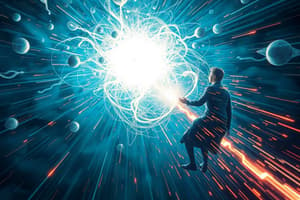Podcast
Questions and Answers
Which term refers to a push or pull upon an object that changes its state of rest or motion?
Which term refers to a push or pull upon an object that changes its state of rest or motion?
- Friction
- Acceleration
- Force (correct)
- Velocity
According to Newton's first law of motion, what happens to the velocity of an object if no net force acts on it?
According to Newton's first law of motion, what happens to the velocity of an object if no net force acts on it?
- It remains constant (correct)
- It increases
- It becomes zero
- It decreases
What quantity describes both the size and direction of a force?
What quantity describes both the size and direction of a force?
- Acceleration
- Mass (correct)
- Speed
- Velocity
What does Newton's second law of motion state about the relationship between force, mass, and acceleration?
What does Newton's second law of motion state about the relationship between force, mass, and acceleration?
What type of forces act across space without any intermediate material?
What type of forces act across space without any intermediate material?
Which type of motion involves an object moving in a straight line?
Which type of motion involves an object moving in a straight line?
Flashcards are hidden until you start studying
Study Notes
Force and Motion
Force is a push or pull upon an object that changes its state of rest or motion. It is a vector quantity, which means it has both magnitude (size) and direction. Newton's first law of motion states that if no net force acts on an object, its velocity will remain constant. This concept is known as inertia.
Motion refers to any change in the position of an object with respect to time. There are several types of motion, including rectilinear motion, circular motion, uniform motion, nonuniform motion, and projectile motion.
Newton's second law of motion relates force to acceleration:
F = m * a
where F is the net force acting on an object, m is the mass of the object, and a is its acceleration. This equation tells us that the more mass an object has, the less force is required to move it with the same acceleration.
Types of Forces
There are two types of forces: contact forces and field forces. Contact forces arise when one surface comes into contact with another; for example, friction, normal forces, tension, and compression. Field forces act across space without any intermediate material; for example, gravity.
Gravity
Gravity is a type of field force exerted by all matter, and it follows an inverse square law. This means that the gravitational force between two bodies decreases as they get farther apart. For example, if two objects are twice as far from each other, their gravitational attraction will decrease fourfold.
Friction
Friction is a contact force that opposes motion between two surfaces. If there were no friction, cars wouldn't stop at red lights, and children would slide off the top of a tire swing.
Applications of Force and Motion
The principles of force and motion have applications in various fields such as physics, engineering, computer science, and biology. In physics, these principles help explain the behavior of natural systems like planets orbiting the sun. In engineering, understanding force and motion helps design bridges, buildings, and machines. In computer science, simulations use the laws of physics to model realistic environments. And in biology, evolutionary theory can be explained through the concepts of energy conservation and fitness maximization.
Studying That Suits You
Use AI to generate personalized quizzes and flashcards to suit your learning preferences.




